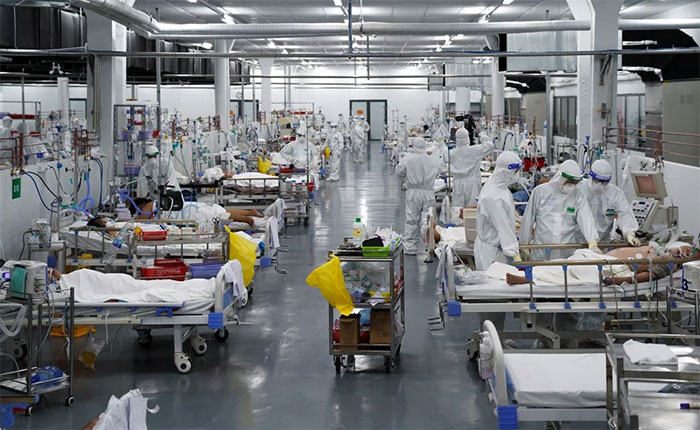According to the Ministry of Health, individuals with low-risk Covid-19 will be cared for at home if their residence meets the necessary regulations.
The Ministry of Health has just issued Decision No. 5525 along with guidelines for classifying the risk of individuals infected with SARS-CoV-2 and directives for management, isolation, and treatment. This decision replaces Decision No. 3646 issued on July 31.
4 Risk Groups
According to these guidelines, classification is based on 4 risk groups (indicated by red, orange, yellow, and green colors) along with directives for management, isolation, and treatment:
Low Risk (Green): Age from ≥ 3 months to ≤ 49 years with no underlying health conditions detected, fully vaccinated, and no abnormal health signs, with SpO2 at 97% or above.
This group will receive care at home (if conditions meet regulations). Health stations, healthcare workers, and volunteers will monitor and manage infected individuals, detecting early signs of deterioration. Additionally, healthcare workers need to provide psychological support, nutrition, exercise, continuous health monitoring, and risk assessment. Simultaneously, individuals will be provided with a home care package (including antiviral medication, vitamins, and essential supplies).
Medium Risk (Yellow): Aged 50 to 64 years with no underlying health conditions detected and fully vaccinated; aged from ≥ 3 months to ≤ 49 years and not fully vaccinated; showing symptoms such as fever, cough, sore throat, mild shortness of breath, etc. SpO2 at 97% or above. This group will be treated in hospitals or facilities designated for Covid-19 treatment at level 1. If local level 1 treatment facilities are overwhelmed, consideration may be given to community treatment.
According to the guidelines, the medium-risk group needs close monitoring to detect early signs that require immediate hospitalization or transfer to a higher level of care. Treatment will include antiviral medication; symptom management such as fever reduction, pain relief, cough suppression, along with enhancing physical condition, nutrition, physical therapy, psychological support, and self-health monitoring.

Inside the Covid-19 patient treatment area at the Covid-19 Intensive Care Center – Hue Central Hospital. (Photo: Chi Hung).
High Risk (Orange): Aged ≥ 65 and fully vaccinated; having underlying health conditions and fully vaccinated; aged 50 to 64 years, no underlying health conditions detected, and not fully vaccinated; pregnant women or women who have given birth ≤ 42 days; children ≤ 3 months old; SpO2 from 94% to 96%.
This group will be treated in receiving hospitals designated for Covid-19 treatment at level 2. Patients need to be monitored for early signs of deterioration; treatment will include antiviral medication, nutrition, prophylactic anticoagulation therapy, ensuring readiness for oxygen support and anti-inflammatory medication in cases of respiratory distress; monitoring treatment in conjunction with underlying health conditions.
Very High Risk (Red): Aged ≥ 65 and not fully vaccinated; having underlying health conditions and not fully vaccinated; experiencing emergency conditions; SpO2
For the very high-risk group, respiratory support is required: Oxygen therapy, High-Flow Nasal Cannula (HFNC), mechanical ventilation, ECMO (extracorporeal membrane oxygenation), support for organ dysfunction (dialysis, blood filtration, cardiac support, vasopressors, etc.). Additionally, treatment will include anti-inflammatory, anticoagulant, antibiotic therapies, physical therapy, rehabilitation, and prevention of complications; monitoring treatment in conjunction with underlying health conditions, transferring to a lower level of care if treatment for F0 is effective.
Principles for Treating Covid-19 Patients
Furthermore, the Ministry of Health also provides 7 principles for treating F0 patients.
- Monitor and care for asymptomatic and mild cases of SARS-CoV-2 at home if conditions allow. Focus on effective treatment at level 1 and level 2 for patients, enhancing emergency and intensive care capabilities for severe cases at higher levels.
- Each receiving facility should arrange at least 2 levels of treatment and ensure the ratio of intensive care beds according to the treatment hierarchy.
- Assess risk and closely monitor the patient’s condition, proactively predicting situations that may worsen to provide appropriate treatment and early intervention.
- Update, comply with, and implement treatment guidelines and protocols to minimize the progression of patients to severe conditions and mortality at treatment facilities.
- Nutrition, hydration, and mental health support play a crucial role and should be prioritized just like medication and medical interventions for effective treatment and reducing mortality.
- Strengthen connections, consultations, and remote treatment advice, with higher levels guiding lower levels for effective treatment at lower levels.
- The community, primary healthcare, and hospitals receiving and treating Covid-19 must strictly implement risk classification. However, based on the clinical condition of the patient and the availability of beds, healthcare facilities (treating physicians) have the right to decide on transferring patients to a bed type that aligns with reality.
China announces discovery of antibody neutralizing all Covid-19 variants
Symptoms when infected with the new Omicron Covid variant
Discovery of a “super variant” of Covid-19 with 32 mutations: Virologist says it’s truly alarming


















































